Introduction
Anxious attachment style, one of the four primary attachment styles, can significantly influence how individuals form and maintain relationships. Rooted in early childhood experiences, it often shapes our emotional landscape and interpersonal dynamics. In this article, we’ll delve into the intricacies of anxious attachment style, explore its origins, identify common behaviors, and discuss strategies for managing its impact on relationships.
What is Anxious Attachment Style?
The Basics
Anxious attachment style, also known as anxious-preoccupied attachment, is characterized by a deep-seated fear of abandonment and a constant need for reassurance from partners. Individuals with this attachment style often experience heightened emotional responses and may struggle with feelings of insecurity and self-doubt.
Origins of Anxious Attachment
This attachment style typically develops during early childhood, particularly if a caregiver was inconsistent in their availability and responsiveness. Children who experienced unpredictable care may grow up feeling uncertain about their caregivers’ reliability, leading to a persistent need for closeness and validation in adult relationships.
Identifying Anxious Attachment Behaviors
Seeking Reassurance
People with an anxious attachment style often seek continuous reassurance from their partners. This can manifest as frequent calls or texts, needing constant affirmation of love, and feeling uneasy when their partner is not immediately available.
Fear of Abandonment
A pervasive fear of being left or abandoned is central to anxious attachment. This fear can lead to clingy or possessive behaviors, as well as difficulty trusting that their partner will remain committed.
Emotional Reactivity
Individuals with anxious attachment may experience intense emotions and have difficulty managing their reactions. They might overanalyze interactions, read into small cues, and react strongly to perceived threats to the relationship.
The Impact on Relationships
Intimacy and Dependency
While individuals with an anxious attachment style crave intimacy, their dependency on their partner’s validation can put a strain on the relationship. Partners may feel overwhelmed by the constant need for reassurance and struggle with the pressure to meet their needs.
Conflict and Communication
Anxious attachment can lead to heightened conflict due to misunderstandings and miscommunications. Individuals may become overly sensitive to their partner’s actions, interpreting neutral behaviors as signs of rejection or disinterest.
Cycle of Insecurity
The cycle of seeking reassurance and experiencing emotional highs and lows can create a turbulent relationship dynamic. This pattern can perpetuate feelings of insecurity and contribute to an unstable relationship environment.
Managing Anxious Attachment
Self-Awareness and Reflection
Developing self-awareness is the first step in managing anxious attachment. Recognizing patterns of behavior and understanding their origins can help individuals take a proactive approach to addressing their attachment style.
Building Self-Esteem
Strengthening self-esteem and self-worth can reduce the dependency on external validation. Engaging in activities that foster self-confidence and self-acceptance can empower individuals to feel more secure within themselves.
Effective Communication
Improving communication skills is crucial for individuals with anxious attachment. Learning to express needs and concerns calmly and constructively can help reduce misunderstandings and create a healthier dialogue with partners.
Seeking Professional Help
Therapy can be highly beneficial for managing anxious attachment. A therapist can provide tools and strategies to address underlying insecurities, improve emotional regulation, and develop healthier relationship patterns.
Conclusion
Anxious attachment style, while challenging, can be navigated with self-awareness and effort. By understanding its origins, recognizing behaviors, and implementing strategies for management, individuals can foster more secure and fulfilling relationships. Remember, the journey towards emotional well-being is ongoing, and seeking support when needed is a sign of strength, not weakness.

